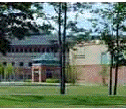| General
Information Textbook: None
Instructor: G.
Ahmadi (CAMP 267, 268-2322)
Office Hours: MW 1:00 - 3:15 p.m., T 1:00 - 1:30 p.m.
Course Website: http://www.clarkson.edu/projects/crcd/me437/
Prerequisites: ME326 or equivalent.
Course
Objectives
- To provide a fundamentals of aerosol transport
deposition and removal in laminar flows.
- To provide a fundamentals of particles adhesion
and removal from surfaces.
- To familiarize the students with the computational
modeling of particle resuspension in laminar flows.
- To familiarize the students with the industrial
applications of aerosols.
Course
Learning Outcomes
Outcome
1:
- Students will be able to formulate and solve
aerosol tranport and deposition in laminar flows.
Outcome
2:
- Students will be able to analyze adhesion and
removal of micro- and nano- particles.
Outcome
3:
- Students
will become familiar with computational fluid mechanics and particle
trajectory analysis procedures.
- Students
will demonstrate using the FLUENT Code for solving aerosol transport
in laminar flows.
- Student
will become familiar with the experimental procedure for particle
adhesion and removal analysis.
Outcome
4:
- Students
will become familiar with the microcontamination problems in microelectronic
and imaging industries.
- Students
will become familiar with surface cleaning including ultrsonic
cleaning.
Course
Outline
ENGINEERING MATHEMATICS
Special Functions
Differential Equations
Fourier Series
Laplace Transforms
Probability and Random Processes
Linear Systems
Useful Integrals
Vector Identities |
VISCOUS
FLOWS
Navier-Stokes Equation, Vorticity, Stream Function
Cylindrical Coordinates
Exact Solutions
Drag on Spherical Particles
Creeping Flows
Nonspherical Particles |
REVIEW
OF COMPUTATIONAL FLUID MECHANICS
Introduction to Fluent and Gambit |
AEROSOLS
Introduction to Aerosols
Stokes Drag, Lift Forces
Aerosol Kinetics
Virtual Mass, Basset Forces, and the BBO Equation
Nonspherical Particles
Brownian Motions
Diffusion and Interception
Particle Deposition Mechanisms
Aerosol Coagulation |
PARTICLE
ADHESION
van der Waals Force
JKR and Other Adhesion Models
Particle Adhesion and Removal
Effects of Charge and Humidity
Utrasonic and Megasonic Cleaning |
SIMULATION
METHODS
Laminar Flow Simulation
Particle Transport and Deposition in Laminar
Flow |
EXPERIMENTAL
TECHNIQUES
Particle Adhesion and Resuspension
Aerosol Sampling Techniques
Clean Room Operation
Advanced Surface Cleaning Techniques |
APPLICATIONS
Microcontamination Control
Xerography
Clean Room and Process Equipment
Filtration Processes and Gas Cleaning |
Evaluation
Methods
- Exam 1: 25% (October 22, 2002,
CAMP 178, 6:30-8:00 pm)
- Final Exam: 30% (Final Exam week)
- Computational Projects 30%
- Laboratory work 5%
- Homework 10%
Course
Description
ME
437 Fluid Mechanics of Aerosol Dispersion R-3, C-3.
Prerequisites: ME 326 or equivalent.
Review of viscous flow theory. Creeping flows around a sphere. Drag
and lift forces acting on particles. Wall effects and nonspherical
particles. Diffusion of aerosols in laminar flows. Brownian motion
and Langevin equation. Mass diffusion in pipe and boundary layer
flows. Dispersion of particles in turbulent flows. Turbulent diffusion
and wall deposition of aerosols. Effects of electrostatics, van
der Waals and other surface forces. Computational aspects of aerosol
dispersion in laminar and turbulent flows. Particle removal and
resuspension from surfaces. Coagulation of aerosols due to Brownian
movement, presence of a shear field and turbulence. Applications
to microcontamination control, air pollution, and particle deposition
in human lung.
Exam
and Homework Policies
Exam
Policy
Exams will be
open handout. The students are permitted to bring their handout
notes to the exams. Other notes and homework solutions are
not allowed.
Homework
Policy
Homeworks will
be collected on every Monday. The homework will be graded and returned
to the students.
References
- W.C. Hinds, Aerosol Science and Technology, Wiley (1983,
1999).
- J. Happel and H. Brenner, Low Reynolds Number Hydrodynamics,
Martinus Nijhoff (1983).
- N.A. Fuchs, The Mechanics of Aerosols, Dover (1989).
- V.G. Levich, Physicochemicals Hydrodynamics, Prentice-Hall
(1962).
- F. White, Viscous Flow, McGraw Hill (1974).
- R.L. Panton, Incompressible Flow, John Wiley (1984).
- H. Schlichting, Boundary Layer Theory, McGraw Hill
(1979).
- J.O. Hinze, Turbulence, McGraw Hill (1975).
- H. Tennekes and J.L. Lumley, A First Course in Turbulence,
MIT Press (1981).
- G.M. Hidy, Aerosols, Academic Press (1984).
- G.M. Hidy and J.R. Brook, The Dynamics of Aerocolloididal
Systems, Pergamon Press (1970).
- Papavergos and Hedley, Chem. Eng. Rs. Des., Vol. 62, September
1984, pp. 275-295.
- S.K. Friedlander, Smoke, Dust and Haze, Wiley (1977).
- J. H. Vincent, Aerosol Science for Industrial Hygienists,
Pergamon Press (1995).
|




















